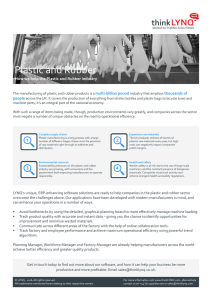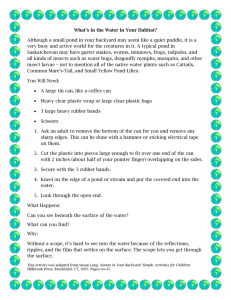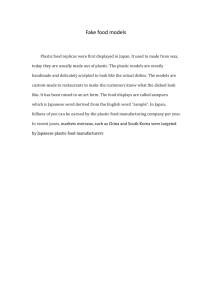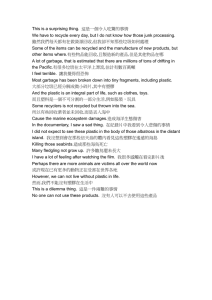Designing Plastic
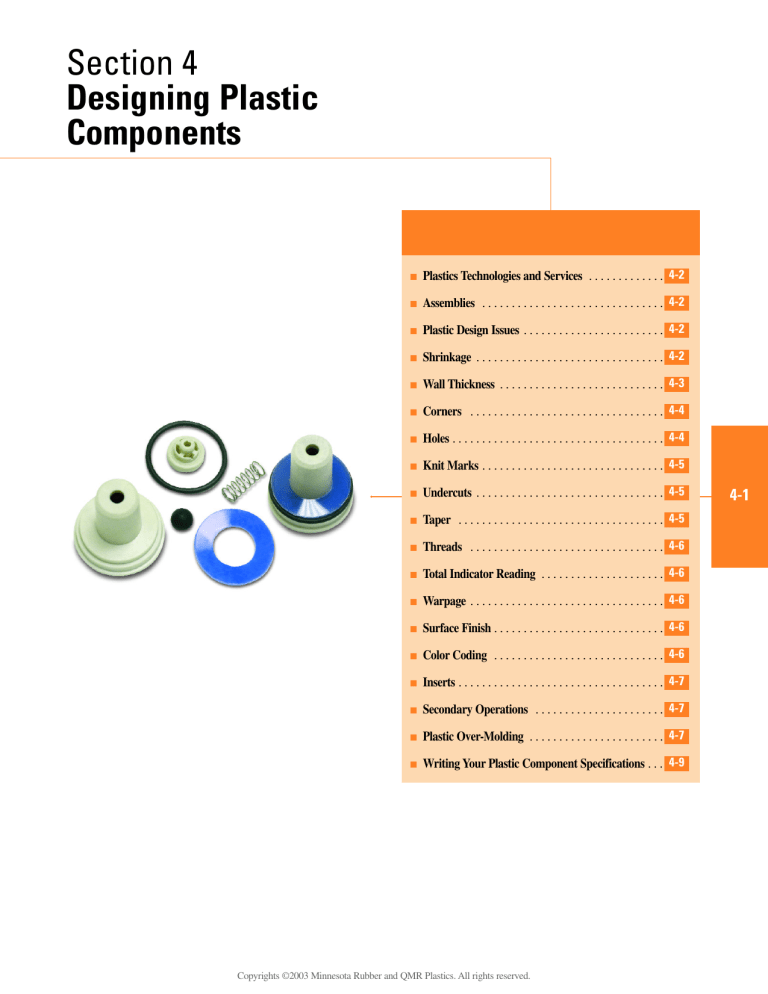
Section 4
Designing Plastic
Components
■ Plastics Technologies and Services . . . . . . . . . . . . .
4-2
■
Assemblies . . . . . . . . . . . . . . . . . . . . . . . . . . . . . . .
4-2
■ Plastic Design Issues . . . . . . . . . . . . . . . . . . . . . . . .
4-2
■
Shrinkage . . . . . . . . . . . . . . . . . . . . . . . . . . . . . . . .
4-2
■ Wall Thickness . . . . . . . . . . . . . . . . . . . . . . . . . . . .
4-3
■ Corners . . . . . . . . . . . . . . . . . . . . . . . . . . . . . . . . .
4-4
■
Holes . . . . . . . . . . . . . . . . . . . . . . . . . . . . . . . . . . . .
4-4
■ Knit Marks . . . . . . . . . . . . . . . . . . . . . . . . . . . . . . .
4-5
■
Undercuts . . . . . . . . . . . . . . . . . . . . . . . . . . . . . . . .
4-5
■ Taper . . . . . . . . . . . . . . . . . . . . . . . . . . . . . . . . . . .
4-5
■ Threads . . . . . . . . . . . . . . . . . . . . . . . . . . . . . . . . .
4-6
■
Total Indicator Reading . . . . . . . . . . . . . . . . . . . . .
4-6
■ Warpage . . . . . . . . . . . . . . . . . . . . . . . . . . . . . . . . .
4-6
■
Surface Finish . . . . . . . . . . . . . . . . . . . . . . . . . . . . .
4-6
■ Color Coding . . . . . . . . . . . . . . . . . . . . . . . . . . . . .
4-6
■ Inserts . . . . . . . . . . . . . . . . . . . . . . . . . . . . . . . . . . .
4-7
■
Secondary Operations . . . . . . . . . . . . . . . . . . . . . .
4-7
■ Plastic Over-Molding . . . . . . . . . . . . . . . . . . . . . . .
4-7
■
Writing Your Plastic Component Specifications . . .
4-9
4-1
Copyrights ©2003 Minnesota Rubber and QMR Plastics. All rights reserved.
Designing Plastic
Components
Plastics Technologies and Services
QMR Plastics offers a wide range of technical services and production capabilities for producing close tolerance components. Our specialty processes and services include:
■ Hotplate, rotational and ultrasonic welding
■ Adhesive bonding, hot stamping and machining
■ Bonding for plastic to metal, plastic to rubber and plastic to plastic
4-2
Assemblies
Our experience in applications for high performance materials and thermoplastic elastomers allows us to view a new design or re-design criteria objectively. As the components we produce are typically part of a larger assembly many customers have benefited from our part consolidation recommendations that allow us to design, develop, manufacture, test, package and ship their completed assembly.
In order to meet critical time-to-market requirements we provide creative solutions for assembly programs. Whether it is a simple two component sub-assembly or a complex, multi-component rubber and plastic assembly that incorporates inserts, and hotplate welding, we offer cost-effective engineered solutions.
What’s more, we know how to maintain the integrity of your basic design while taking into consideration factors such as shrink distortion and parting lines; this helps avoid surprises when it comes time to manufacture, assemble and use the end product.
As the relationship between materials, parts and end-use performance need to be addressed, we also know how to solve problems arising from torque values and sealing contacts. We then ensure that the rubber and plastic materials complement each other’s tolerance capabilities.
Once the design is complete, we can follow through with testing through the use of tools, such as FEA, where benefits such as increased strength, reduced material use and reduced costs can be realized.
Plastic Design Issues
Injection molded plastic parts offer an important combination of flexibility, toughness, and chemical resistance for cost effective, long-term performance in a wide range of applications. However, not every plastic part design can be efficiently injection molded. So working with us early in the design process is important. With our experience in plastics materials and molding, we can help you design parts that are both functional and within budget.
Shrinkage
Thermoplastic materials are heated in the barrel and injected into the mold cavity. As the part cools in the mold, it shrinks.
Thick cross-section areas cool at a substantially lower rate than thin cross-sections, and press cycle time is based on the cooling rate of the thickest cross-section.
Therefore, even one relatively thick cross-section area will increase the press cycle time, thereby reducing the number of parts per hour and increasing the cost per part.
Correct Incorrect Distortion and Sink
The uneven rate of cooling of these thick and thin cross-sections is also likely to result in distortion of the part after it has been removed from the mold.
This distortion is often severe enough to prevent the part from meeting specifications.
A thick cross-section is also likely to result in a depression on the surface called a sink mark, particularly if the cross-section is of varying widths.
A good rule of thumb is to design all part crosssections as thinly and uniformly as possible. The use of ribs is an effective way of achieving rigidity and strength while avoiding cross-sectional thickness.
In cases where it is impossible to avoid a thick cross-section, ribs may also help to minimize the distortion that can occur during post-cure. Very complex shapes that must combine thick and thin cross-section should be reviewed in advance so as to determine dimensional stability and tolerance changes that will occur during and after molding.
Wall Thickness
Uniform wall thickness is critical in part design for an injection molded part. Non-uniform wall thickness causes dimensional control problems, warpage and other part integrity issues.
Production techniques on thin walls become quite complicated. For efficient, high volume production, we recommend a minimum wall thickness of .025-.030
(.635-.762mm) on small parts, .040-.050 (1.02-1.27mm) on larger parts.
Correct
Correct
Correct
Incorrect
Incorrect
4-3
Incorrect
Correct Incorrect
Corners
Two key points to keep in mind when designing part corners: the mold is machined from steel, and it’s easier to machine a radius than a square corner.
Therefore, whenever possible, when viewed from the top, the part should display round corners. When seen from the side, the edges should be square.
Holes
A hole or I.D. is created in a part by inserting a core pin in the cavity. Holes at a right angle to the mold parting line are relatively easy to produce since the core pin is parallel to the injection path. The normal shrinkage process, however, can cause the part to cling to the core as it cools in the mold. In order to facilitate ejection of the part from the mold, a draft should be incorporated along the length of the hole.
PARTING
LINE
4-4
Correct
Incorrect
Also, due to the flow characteristics of the molten material during the molding process, square corners tend to be weaker than rounded corners. To ensure dimensional stability, we recommend a minimum radius of .010 (.254mm) .
CORE PIN
Holes that are parallel to the mold parting line call for the use of a sliding core that automatically retracts from the part as the mold opens. The use of sliding cores adds to the cost and complexity of tool design and construction.
If a hole does pass completely through a part, or if the part contains holes on more than one side, the mold must be designed to hold the part on a specific side of the open mold to facilitate automatic parts unloading.
Correct Incorrect
SLIDING
CORE PIN
Long, fragile cores tend to warp or break under continuous use due to the heat and pressure of their operating environment. The size of the core pin, and thus the diameter of the hole, should therefore be maximized whenever possible, particularly at the base, to ensure the stability of the pin. A useful rule of thumb to remember when designing part holes is the “2.1 rule”: The height of the hole should not be more than twice its diameter.
Undercuts
The ease with which a plastic part is removed from the mold is determined in large part by the presence and depth of undercuts, the cross-section thickness, and the flexibility of the thermoplastic material. The undercut must be shallow or the material must have considerable “give” in order to allow the core pin to be “snapped” from the molded part.
Parts featuring an undercut on the O.D. are often molded by a split-shell process. Deeper undercuts on the O.D. may require the use of a more expensive sliding core mold.
EJECTION
SLEEVE Preferred Alternate Least Preferred
Knit Marks
A core pin blocks the normal path of the molten material as it enters the mold. A weak point called a knit mark can be created on the “back side” of the pin where the material flows together. These weak points can be eliminated by proper placement of the gate, or material entry point. It is therefore critical that you call out areas where knit marks cannot be tolerated so that potential problems can be eliminated in the mold design stage.
Taper
Part surfaces should be tapered slightly to facilitate ejection of the part from the mold, especially in high speed, high volume production applications. Surfaces to be tapered include holes, cavities and internal grooves, as well the O.D.
4-5
KNIT
MARKS
Threads
Threads can be molded into your plastic part on either the
I.D. or O.D. surface. An O.D. thread design must include a non-threaded surface, or land, extending from one end of the thread approximately one and one-half times the thickness of the thread. I.D. threads should be a maximum of .050 (1.27mm) long, and no finer than 32 threads per inch
(12 threads/cm) , as fine threads molded in plastic tend to be very weak.
LAND
Warpage
Some warpage can be expected with any molded plastic part. The amount of warpage will vary with the type of thermoplastic material being used. A good rule of thumb for most material and part configurations is .010 distortion per 3.00 part length
(.033mm/cm) .
TRUE
LINE
4-6
Correct Incorrect
Total Indicator Reading
Total Indicator Reading (TIR) measures roundness in relationship to a center line. TIR is expressed in total diametric deviation: ±.004 (.102mm) deviation is defined as ± .008 (.203mm) TIR. Roundness tolerances for molded plastic parts should not exceed ± .007 per inch diameter
(.07mm/cm) , with a minimum TIR of ±.005 (.127mm
).
–
5
4
6
3
2
1
.300
(7.62mm)
1
2
3
+
4
5
6
.306
(7.77mm)
.294
(7.47mm)
–
5
4
6
3
2
1 1
2
3
+
4
5
6
.300
(7.62mm)
5
6
–
4
3
2
1 1
2
3
+
4
5
6
+.006 (.15mm) is defined
as .012 (.3mm) TIR
Surface Finish
Molded plastic parts may be designed with a variety of surface finishes, from glossy polish to a rough texture.
The choice of surface finish is normally based on cosmetic considerations. A glossy finish can enhance the appearance of a part, while a textured surface may help to mask sink marks or parting lines.
Surface finish should be specified so as not to interfere with ejection of the part from the mold. The smoother the finish, the more easily the part will be removed from the mold. An extremely rough surface may function much like an O.D. undercut, preventing the part from slipping easily from the mold.
When not otherwise specified, we adhere to the surface finish standards of the Society of Plastic Engineers and the Society of Plastic Industries.
Color Coding
Molded plastic parts are easily produced in a wide range of colors. Some plastic formulations, however, do include strongly colored fillers whose color is not easily altered by the addition of other pigments. The proportion of pigments to plastic is small, so as to have very little effect on the performance of the part.
Coloring agents do, however affect the shrinkage characteristics of the plastic. Thus, parts of different colors produced from the same material in the same mold will have different dimensions.
The addition of color pigments does not delay the production process, since color mixing is done in our facility as part of the material formulation process.
Finished parts can also be hot-stamped with part numbers and company designations.
Inserts
Steel, brass, or aluminum components are commonly inserted into plastic parts during or after the molding process. A knurled, ribbed or abraded surface on the metal part helps to ensure a strong, permanent bond between metal and plastic. Our design engineers can provide you with more information and assistance in designing your inserts.
Secondary Operations
Most parts are shipped “as molded.” Some parts however require minor cleaning, normally accomplished using one of several types of tumblers. Gate marks can also be removed by buffing, grinding or trimming.
Tapping, drilling, insertion, assembly, bonding, decorating or other secondary operations are sometimes used to facilitate the production process. In order to decrease mold complexity or improve production throughout, for example, a part feature might be more easily added after molding.
Plastic Over-Molding
Over-molding onto plastic inserts can solve many design problems. The flexibility, toughness, solvent and chemical resistance of rubber is combined with rigidity, light weight, and costs savings of plastic.
Material with a heat deflection temperature of less than
400°F (204°C) should normally be avoided for rubber-to-plastic molding as the intense heat and pressure of the rubber molding press may cause the plastic part to reflow and distort.
Plastic materials commonly used in the bonding process include nylon, polycarbonate, modified PPO, polysulfone, and polyphyenylene sulfide.
Even these ideal materials will experience some shrinkage.
We recommend a starting tolerance of +.005 inch (.127mm) .
This tolerance would increase, however, for diameters of more than .250 inch (6.35mm) .
Correct
INSERT
.015 MIN
(.381mm)
.015 MIN
(.381mm)
INSERT
Incorrect
Correct Incorrect
The heat and pressure of the rubber flow tends to warp or crush plastic threads, as well. Even if the threads are located away from the rubber flow, shrinkage due to heating is likely.
In order to avoid this problem, we recommend that plastic threads be ground after the rubber molding process.
Undercuts are subject to the same stresses and may collapse or shrink to some extent. The tolerance on undercuts, however, is usually more forgiving and predictable. Envelop as much of the plastic insert in rubber as possible. This
4-7
simplifies insert design and eliminates tedious flash removal.
This technique also improves bonding by increasing surfaceto-surface contact and/or by supplementing the chemical bond with a mechanical bond.
.015 MIN
(.381mm)
Correct
INSERT
Unsupported areas of a part, such as large, flat surfaces not covered by rubber, are especially prone to warping.
Such areas may be supported by the tool itself; more often, however, this support must be incorporated into the part design.
Providing this support is not always simple. A part such as the one shown below may have to be produced in two stages. A sliding core would be required in the rubber mold to support the part. In this case, it may be simpler to ultrasonically weld the flat insert to the funnel-shaped section after the rubber molding process. The insert must still be supported by pins on one side so that the rubber can flow over the horizontal surface of the insert.
4-8
Incorrect
INSERT
In cases where the rubber cannot be allowed to cover the entire surface of the insert, a mechanical barrier, called a seal-off, must be incorporated into the insert design.
SEAL-OFF
Correct
ULTRASONIC
WELD
Note: Seal-off is crushed during
overmolding
Sliding pins often leave marks on the part surface, which may be a concern in cases where appearance is critical.
Also, the part surface may be discolored by the adhesive that is applied to the part prior to molding. Further discoloration usually occurs during molding and deflashing.
If color and appearance are important, the part should be designed so that the rubber completely covers the plastic insert. Silicone rubbers can be specified in a variety of bright hues, whereas other rubber materials are generally available in only dark or dull colors.
Incorrect
Note: Flash from overmolding
without seal-off
Writing Your Plastic Component Specifications
(For rubber components, see our “Writing Your Rubber Component Specifications” in Section 2)
Contact:
Company name:
Address:
Part name:
Basic description and function of part in application:
Phone: e-mail:
Date:
Fax:
Part number:
Estimated annual usage (EAU):
Target price:
Life expectancy:
Material:
Part data base available?
Describe assembly operation:
Yes No
Assembly methods and equipment currently used:
Cost of present part:
Color:
Prototypes available?
Can assembly be simplified?
Temperature conditions:
Yes
■
Minimum
■
Continuous
Testing Requirement:
No
■
■
Maximum
Intermittent
Operating environment part is exposed to (i.e.: fluids, chemicals, solids):
Significance of media contact (i.e: splash, submersion, mist, fumes, subject to dry):
Yes No continued on reverse
4-9
Describe performance requirements (i.e.: structural, torque, tension):
Load frequency (i.e.: static dynamic, cycling, impact, RPM, interference, FPM, stroke length):
4-10
Does plastic come in contact with rubber parts?
If so, what type of rubber compound?
Material and surface contact points of mating parts:
Anticipated Q.A. requirements:
Yes No
Aesthetic requirements (i.e.: weld lines, parting lines, gate location):
Gate extension: ■ Minimum
Critical features of functional requirements:
■ Maximum
Are tolerances correct and applicable?
Can multiple parts or functions be combined?
Yes
Is special packaging required?
Yes
Yes
No
No
No
Additional comments:
Make a sketch or attach a print if the part is easier to illustrate than to describe:
Copyrights ©2003 Minnesota Rubber and QMR Plastics. All rights reserved.

